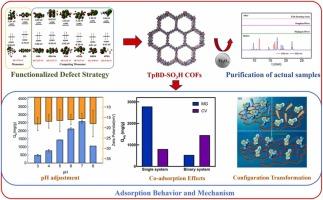基于功能缺陷策略的纳米核壳磁SO₃h功能化共价有机骨架在阳离子染料净化中的吸附行为与机理
IF 11.3
1区 环境科学与生态学
Q1 ENGINEERING, ENVIRONMENTAL
引用次数: 0
摘要
随着纺织印染和水产养殖业的迅速发展,迫切需要对染料废水进行高效处理。本文以4-氨基苯-1,3-二磺酸(ADSA)为竞争单体,通过功能缺陷策略合成了磁性磺酸功能化共价有机骨架(Fe3O4@TpBD-SO3H COFs),生成了周期型富磺酸纳米吸附剂。孔雀石绿(MG)和结晶紫(CV)在单一和二元体系中的吸附实验,在吸附模型拟合的支持下,表明它们通过非平行分子取向进行多分子吸附。在二元吸附体系中,MG增强CV吸附(协同作用),CV抑制MG吸附(拮抗作用)。动态竞争吸附试验表明,单体系和二元体系之间的吸附结构转变影响了这种共吸附现象。加入Fe3O4磁芯使Fe3O4@TpBD-SO3H COFs具有高亲水性,对MG (1010.6 MG /g)等阳离子染料具有优异的吸附能力,而对阴离子染料的吸附能力最低。此外,该材料具有较强的抗金属盐干扰能力,并在6次再生循环后保持稳定的吸附性能。实际废水样品的成功净化进一步证明了其在复杂水系统中选择性阳离子染料去除的实际潜力。本文章由计算机程序翻译,如有差异,请以英文原文为准。

Nano-Size Core-Shell Magnetic SO₃H-Functionalized Covalent Organic Frameworks Via a Functional Defect Strategy for Cationic Dye Purification: Adsorption Behavior and Mechanism
With the rapid expansion of textile printing and aquaculture industries, efficient dye wastewater treatment is urgently needed. Here, magnetic sulfonic acid-functionalized covalent organic frameworks (Fe3O4@TpBD-SO3H COFs) were synthesized via a functional defect strategy using 4-aminobenzene-1,3-disulfonic acid (ADSA) as a competing monomer, generating periodic and sulfonate-rich nano adsorbent. Adsorption experiments involving malachite green (MG) and crystal violet (CV) in single and binary systems, supported by adsorption model fitting, indicated multimolecular adsorption through non-parallel molecular orientations. In binary adsorption system, MG enhanced CV adsorption (synergistic effect), whereas CV suppressed MG adsorption (antagonistic effect). Dynamic competitive adsorption tests suggested that adsorption configuration transitions between single and binary systems influenced this co-adsorption phenomenon. Incorporating Fe3O4 magnetic cores rendered Fe3O4@TpBD-SO3H COFs highly hydrophilic, achieving excellent adsorption capacities for MG (1010.6 mg/g) and other cationic dyes, while minimally adsorbing anionic dyes. Moreover, the material exhibited strong resistance to interference from metal salts and maintained stable adsorption performance after six regeneration cycles. Successful purification of real wastewater samples further demonstrates its practical potential for selective cationic dye removal from complex aqueous systems.
求助全文
通过发布文献求助,成功后即可免费获取论文全文。
去求助
来源期刊

Journal of Hazardous Materials
工程技术-工程:环境
CiteScore
25.40
自引率
5.90%
发文量
3059
审稿时长
58 days
期刊介绍:
The Journal of Hazardous Materials serves as a global platform for promoting cutting-edge research in the field of Environmental Science and Engineering. Our publication features a wide range of articles, including full-length research papers, review articles, and perspectives, with the aim of enhancing our understanding of the dangers and risks associated with various materials concerning public health and the environment. It is important to note that the term "environmental contaminants" refers specifically to substances that pose hazardous effects through contamination, while excluding those that do not have such impacts on the environment or human health. Moreover, we emphasize the distinction between wastes and hazardous materials in order to provide further clarity on the scope of the journal. We have a keen interest in exploring specific compounds and microbial agents that have adverse effects on the environment.
 求助内容:
求助内容: 应助结果提醒方式:
应助结果提醒方式:


